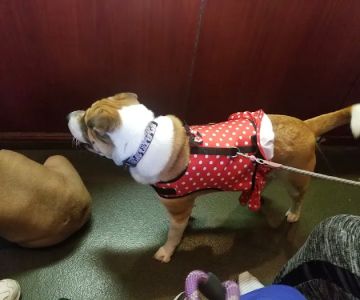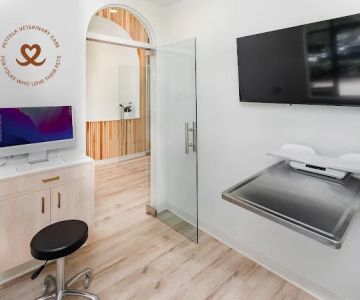How to Care for Your Dog After a Dental Procedure
As a pet owner, I’ve always known how important dental health is for our furry friends. But after my dog, Max, had to undergo a dental procedure, I learned just how critical it is to provide the proper care during the recovery process. Like many dog owners, I was a little nervous about how to care for him after the procedure, but after speaking with the vet and doing some research, I felt more confident in what needed to be done. If your dog has recently had dental work, this guide will walk you through the essential steps to ensure a smooth and comfortable recovery.
1. Follow the Vet's Post-Procedure Instructions
The first and most important thing I learned is to always follow the instructions given by your vet. These instructions will vary depending on the type of dental procedure your dog underwent, whether it was a cleaning, tooth extraction, or a more complex surgery. Your vet will likely provide guidance on things like:
- Medications: Your dog may need painkillers or antibiotics to prevent infection. Be sure to administer these as prescribed.
- Dietary Restrictions: After dental work, your dog may need to eat soft food for a while. Avoid feeding them hard kibble or treats that could irritate their mouth.
- Exercise Limitations: Just like with humans, rest is crucial for recovery. Keep your dog from excessive physical activity to ensure proper healing.
Following these instructions ensures that your dog heals well and doesn’t experience any setbacks. It’s also a great way to show your dog how much you care for them during this recovery phase.
2. Manage Pain and Discomfort
After Max’s dental procedure, I noticed he seemed a bit more sensitive than usual. This is completely normal, as dental work can cause some pain or discomfort in the mouth. It’s crucial to manage this properly to help your dog feel more comfortable and aid in their recovery.
Here’s what I did:
- Use Pain Relief Medication: As prescribed by the vet, I made sure to give Max the painkillers at the appropriate times to ensure he wasn’t in discomfort. Keeping a close watch on him helped me understand when he might need another dose.
- Offer Soft Food: Hard kibble or dry food could hurt their mouth, so I made sure Max had soft food, like boiled chicken or wet dog food, to avoid causing any further irritation.
- Provide a Calm Environment: Max was a little more irritable than usual due to the pain, so I ensured his environment was peaceful and quiet to minimize stress.
By managing pain, you’ll help your dog recover more comfortably and prevent complications like mouth infections or reluctance to eat.
3. Monitor for Complications
While dental procedures are generally safe, there are always potential risks and complications that could arise. It’s important to keep an eye out for any unusual signs during your dog’s recovery. Here are some things I monitored closely with Max:
- Excessive Drooling: A little drooling is normal, but if your dog is drooling excessively or has trouble swallowing, it could be a sign of infection or discomfort that needs attention.
- Swelling or Bleeding: Mild swelling around the gums or mouth may occur, but excessive swelling or bleeding that doesn’t stop after a few hours may require a vet visit.
- Loss of Appetite: If your dog refuses to eat for more than a day or two, this could be a sign of a problem. A lack of appetite should be addressed with your vet to ensure no further complications exist.
If any of these symptoms arise, contact your veterinarian right away to avoid any severe issues and ensure your dog receives the necessary care.
4. Provide a Safe and Comfortable Space for Recovery
After Max’s dental surgery, I found that having a quiet, safe space for him to rest was one of the most effective ways to speed up his recovery. Dogs need a calm environment to heal properly, especially after a procedure that can cause them physical discomfort. This is what I did:
- Set Up a Comfortable Bed: I created a comfy bed in a quiet area of the house, free from distractions. I made sure it was soft, warm, and easy for Max to settle down.
- Limit Movement: I kept Max in a confined area where he couldn’t run around or jump on furniture. This was to avoid putting any strain on his healing mouth and to encourage him to rest.
- Provide Fresh Water: Max was given plenty of fresh water, which helped him stay hydrated, especially since he was on pain medication that could cause mild dehydration.
By creating a peaceful, comfortable environment, I helped Max focus on rest, which is critical for recovery.
5. Gradually Return to Normal Activities
As Max started to heal, I slowly reintroduced his normal activities. This is an important step in ensuring that he doesn’t overexert himself too soon after the procedure. Here’s what I did to ease him back into his usual routine:
- Slowly Reintroduce Exercise: I gradually reintroduced walks and playtime, but at a slower pace. I made sure he wasn’t too active, which could strain his mouth or gums.
- Observe Eating Habits: After a few days, I began feeding Max soft food again and then slowly started incorporating his regular diet.
- Monitor Behavior: I observed his behavior closely, ensuring he didn’t exhibit signs of pain or discomfort when eating or playing.
It’s important to slowly ease your dog back into their regular routine so that their body can continue to heal without unnecessary stress or strain. This approach helped Max recover fully and enjoy his usual activities once again.











